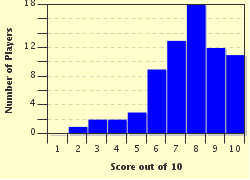Quiz Answer Key and Fun Facts
1. You are at the Kennedy Space Center, sitting in your rocket, ready to launch. You look out the window and view the sky. You are currently sitting at the lowest level of the atmosphere. What is this level called?
2. 3..2..1.. Ignition!! Your rocket lifts off the launchpad and you rise through the atmosphere. Your rocket reaches an altitude of approximately 18 km (11 miles). At this point you have crossed into the second level of Earth's atmosphere. What is the name of it?
3. As you continue to rise, you pass a special area of the atmosphere that protects the Earth from harmful ultraviolet rays emitted by the sun. What is it called?
4. Your rise into the atmosphere continues. At this point your rocket reaches an altitude of approximately 50 km (31 mi). You cross into the central layer of the atmosphere. What is the name of this level?
5. Continuing your ascent, you reach a special area of Earth's atmosphere where molecules start to become ionized. What is this part of the atmosphere called?
6. Your rocket continues to burn and you reach an altitude of approximately 80 km (50 mi) above Earth's surface. What level of the atmosphere do you cross into now?
7. Your rocket approaches an altitude of approximately 160 km (100 mi) above the Earth's surface. It is at this point where you could safely enter LEO or Low Earth Orbit.
8. The International Space Station orbits the Earth from within the thermosphere.
9. As your rocket continues to travel, you reach an altitude of approximately 700 km (440 mi) above the surface of the Earth. What is the name of the final and thinnest layer of the atmosphere?
10. Your rocket eventually reaches an altitude of approximately 1,000 km (620 mi) above the Earth's surface. Here you will reach an area where belts of radiation surround the Earth. What are these belts called?
Source: Author
RedHook13
This quiz was reviewed by FunTrivia editor
rossian before going online.
Any errors found in FunTrivia content are routinely corrected through our feedback system.

